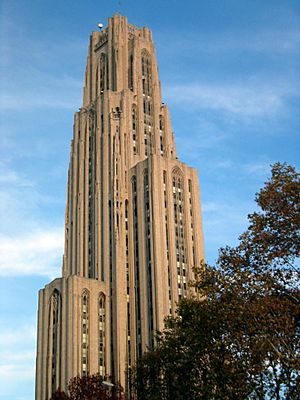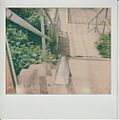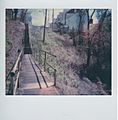Oakland (Pittsburgh) facts for kids
Quick facts for kids
Oakland
|
|
|---|---|
|
Neighborhood of Pittsburgh
Former township |
|

The University of Pittsburgh's Cathedral of Learning dominates Oakland's skyline.
|
|
| Country | United States |
| State | Pennsylvania |
| County | Allegheny |
| Population
(2017)
|
|
| • Total | 8,663 |
| • Density | 11,280/sq mi (4,360/km2) |
| Time zone | UTC-5 (Eastern (EST)) |
| • Summer (DST) | UTC-4 (EDT) |
Oakland is a lively neighborhood in Pittsburgh, Pennsylvania. It's known as a major center for schools, hospitals, and culture. You'll find three universities, many museums, and several hospitals here. There are also lots of shops, restaurants, and fun things to do. Oakland is home to special historic areas like the Schenley Farms Historic District and the Oakland Square Historic District.
Oakland's Neighborhoods
Oakland is split into four main parts: North Oakland, West Oakland, Central Oakland, and South Oakland. Each part has its own unique feel and places to live or visit. Oakland is Pittsburgh's second most populated neighborhood, with over 22,000 people. Many of these residents are students.
You can find 29 different sets of city steps scattered throughout Oakland. These steps help people walk easily through the busy area and connect to public transportation. Some of these steps even have special ramps called "runnels" for bikes!
| Historical population | ||
|---|---|---|
| Year | Pop. | ±% |
| 1940 | 25,843 | — |
| 1950 | 28,430 | +10.0% |
| 1960 | 23,806 | −16.3% |
| 1970 | 22,702 | −4.6% |
| 1980 | 21,157 | −6.8% |
| 1990 | 21,548 | +1.8% |
| 2000 | 20,417 | −5.2% |
| 2010 | 22,210 | +8.8% |
| Source:
|
||
North Oakland: Home to Universities and History
North Oakland is the area between Neville and Bouquet Streets, stretching north towards Polish Hill. This part of Oakland is home to the famous Cathedral of Learning and the engineering buildings of the University of Pittsburgh. The Craig Street business area is also here.
You'll find the Pittsburgh center for RAND and a business incubator on Henry Street. The Islamic Center of Pittsburgh, the city's largest mosque, is also in North Oakland. This area also has the Schenley Farms Historic District and many apartment buildings.
Central Oakland: Student Life and Shops
Central Oakland is next to Schenley Park, the Boulevard of the Allies, Fifth Avenue, and Halket Street. Many students from the University of Pittsburgh choose to live here. A lot of the homes are old, beautiful stone buildings from the early 1900s.
The main shopping and dining area is along Forbes and Fifth Avenue. It has many different restaurants, stores, and banks. Smaller business areas on Atwood Street and Semple Street offer even more food choices. This area also includes the historic neighborhood of Panther Hollow and the Oakland Square Historic District.
South Oakland: River Views and Famous Artists
South Oakland is located along the Monongahela River. It forms a triangle between the river, the Boulevard of the Allies, and Junction Hollow. Important places here include Magee-Womens Hospital of UPMC and the Pittsburgh Technology Center.
This neighborhood has two main parts: a flat area by the river that used to have factories, and a higher area with homes. The higher area is split by Bates Street. The part north of Bates Avenue is called Oakcliffe. The riverfront area now has places like the Entertainment Technology Center of Carnegie Mellon University.
Even though many people think South Oakland is mostly for students, only about 37% of its population is between 18 and 24. This is much less than Central Oakland, where over 74% are students. The area between Forbes Avenue and the Boulevard of the Allies, which many people mistakenly call South Oakland, is actually part of Central Oakland.
South Oakland was the childhood home of famous pop artist Andy Warhol. Later, another pop artist, Keith Haring, lived here and had his first art show. NFL Hall of Fame quarterback Dan Marino was also born in Oakland, very close to Warhol's home. Dan Marino Field on Frazier Street is named after him.
West Oakland: Hospitals and Universities
West Oakland is the smallest of the four parts. It's bordered by Fifth Avenue to the south, DeSoto Street to the east, the Birmingham Bridge to the west, and Allequippa Street to the north. Carlow University and most of the University of Pittsburgh Medical Center are located here.
What's Not in Oakland
Even though they are close by and share the 15213 zip code, the campus of Carnegie Mellon University and parts of Schenley Park, including Phipps Conservatory & Botanical Gardens and Flagstaff Hill, are actually part of the nearby neighborhood of Squirrel Hill North. The border between Oakland and Squirrel Hill is along Junction Hollow.
History of Oakland
The name "Oakland" first appeared in a local newspaper in 1839. The area was named because of the many oak trees on William Eichbaum's farm, who settled there in 1840. Oakland grew quickly after the Great Fire of 1845 in Downtown Pittsburgh, as many people moved to the suburbs. By 1860, there were many businesses along Fifth Avenue.
In 1868, Oakland Township joined the City of Pittsburgh. Later, in 1889, Mary Schenley gave the city 300 acres of land in Oakland for a park. Officials bought another 100 acres from her for what became "Schenley Park." Mary Schenley also gave land for Schenley Plaza. Here, a rich businessman named Andrew Carnegie built a library, museum, and concert hall complex, which opened in 1895.
In 1917, former President Teddy Roosevelt visited Oakland.
Oakland has always been known as Pittsburgh's university center. Carnegie Mellon University was formed in 1967 from two older schools: the Carnegie Institute of Technology (founded in 1900 by Andrew Carnegie) and the Mellon Institute (founded in 1913). The University of Pittsburgh, which started as the Pittsburgh Academy in 1787, moved to Oakland in 1909.
Some of the most amazing buildings in Oakland are on Pitt's campus. In 1925, work began on the Cathedral of Learning. It was once the world's tallest educational building. Today, it's still the second tallest university building in the world and the tallest educational building in the Western Hemisphere. Oakland is also home to the beautiful Heinz Memorial Chapel and St. Paul Cathedral. You can also find the main branch of the Carnegie Library, the Carnegie Museum, and Phipps Conservatory here.
Baseball fans might remember Oakland for Forbes Field. This baseball park was built in 1909 and was home to the Pittsburgh Pirates baseball team and the Pittsburgh Steelers football team. Forbes Field closed in 1970, but some parts of it still remain. Pirates fans gather there every year to celebrate Bill Mazeroski's World Series-winning home run from 1960.
The Decade nightclub was a popular music spot in the neighborhood during the 1970s and 1980s.
Cool Places to Visit in Oakland
Oakland is full of interesting places!
- The huge Carnegie cultural complex, started by Andrew Carnegie, includes the Carnegie Museum of Natural History, Carnegie Museum of Art, Carnegie Library of Pittsburgh, and Carnegie Music Hall.
- You can visit St. Nicholas Greek Orthodox Cathedral, which hosts a yearly Greek Food Festival. There's also St. Paul Cathedral and the nearby Pittsburgh Chinese Church.
- The University of Pittsburgh Medical Center in Oakland is famous for being a pioneer in organ transplant surgery. In 1955, the first effective polio vaccine was created by Dr. Jonas Salk at the University of Pittsburgh School of Medicine.
- Oakland was once home to many professional Pittsburgh sports teams, including the hockey Pittsburgh Pirates (NHL), the Pittsburgh Steelers football team, and the baseball Pittsburgh Pirates. They played at old venues like the Duquesne Gardens, Pitt Stadium, and Forbes Field.
- The Pittsburgh Symphony and many touring shows used to perform at the Syria Mosque. The Pittsburgh Civic Light Opera also performed at Pitt Stadium until 1961. The Pittsburgh Playhouse was founded in Oakland.
- WQED, Pittsburgh's PBS station, has been in Oakland since 1954. It was the first community-supported TV station in the U.S. The famous children's show Mr. Rogers' Neighborhood was filmed at WQED's studios in Oakland.
- WDTV-TV, now KDKA-TV, was the first TV station in the region. It started broadcasting from the Syria Mosque in Oakland in 1949. This event was the first time East Coast and Midwest TV stations were connected into a modern TV network.
- Oakland is less than 3 miles (5 km) from Downtown Pittsburgh. It shares borders with neighborhoods like Shadyside, Squirrel Hill, the Hill District, Greenfield, Bloomfield, and Bluff.
More Fun Places to Explore
Museums and Art Galleries
Music and Theater Venues
Historic Places to See |
Churches
Schools and Hospitals
Libraries
Parks and Gardens
Sculptures and Memorials
|
Gallery
-
North Oakland seen from near the top of the University of Pittsburgh's Cathedral of Learning.
-
Hamerschlag Hall at Carnegie Mellon University
-
The University of Pittsburgh's Cathedral of Learning viewed from the William Pitt Union
-
The University of Pittsburgh's Alumni Hall
-
Panther Hollow Lake in Schenley Park
-
Soldier and Sailors' Memorial on 5th Avenue in North Oakland.
-
Pittsburgh Athletic Association, built 1909-1911, at the corner of Fifth Avenue and Bigelow Boulevard.
-
The former Y.M.H.A., is now Pitt's Bellefield Hall
-
The former Schenley Apartments, now Schenley Quadrangle residences at the University of Pittsburgh
-
The former Schenley Hotel, now the University of Pittsburgh's William Pitt Union.
-
Former Mellon Institute building, now the University of Pittsburgh's Allen Hall
-
The former Ruskin Apartments, now the University of Pittsburgh's Ruskin Hall
-
The former National Union Fire Insurance Company building, now the University of Pittsburgh's Thackeray Hall
-
The Frick Fine Arts Building at the University of Pittsburgh
-
The former William Jacob Holland residence, now the Music Building at the University of Pittsburgh
-
The Stephen Foster Memorial at the University of Pittsburgh




































